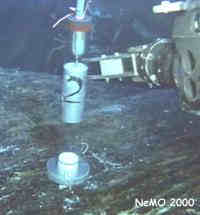| |
Participant
Interview:
Anna Metaxas
Biologist
Dalousie University
Jeff: How did you get started
in larval ecology research?
Anna: While doing rocky intertidal research I realized that one of the
things that we know very little about are the factors that determine larval
supply. We know that larvae leave and come back but not much in between.
They can spend anywhere from 2 hours to years wandering around in the
water column so that's a big gap. There are millions of larvae released
but they aren't all coming back. Somewhere around 90-99% of the released
larvae die. This intrigued me and I thought that this would be something
cool to study.
Jeff: Is studying vent
larvae a side project for you?
Anna: Yes. My general research interest involves looking at the extent
that larvae can out-behave the flow of currents. In terms of the vents,
I've done projects rearing larvae of animals similar to ones at the vents.
Then, when I went to Woods Hole Oceanographic Institution, I got involved
in a big project looking at larval dispersal at vents. Later, I contacted
Verena Tunnicliffe and she invited me to come along on this cruise as
the person to look at larvae at Axial. What I would like to do is relate
larval supply to recruitment at a vent so I could do a spatial description
at different types of vents. I'd like to compare larval supplies in Axial
at ASHES, an older vent, to Cloud, a newer one. Then I'd like to put down
settlement surfaces to see what actually settles in those areas. It's
a comparison between what's available and what actually settles to make
it to a later stage.
Jeff: What stage is vent
larval research in?
Anna: At this stage we can only collect descriptive data, see what happens,
then try to make a hypothesis about how this data relates to the communities
we see, then test it. But until we know what's out there, it's really
hard to decide what factors influence what. Much of what we know about
vent larval dispersal was learned in the Woods Hole project. We don't
know much. The paper from that project hasn't even come out yet. It's
very new. The problem with the larvae is that everyone wants to see tubeworm
larvae and they are the ones we're probably not going to see, simply because
they're so fragile. In my experience the larvae just explode upon contact
with the water-air interface. We'll see what we get out here. They are
hard to get. Gastropod larvae and polycheate larvae are very abundant
and in the few samples that have been collected, were seeing those more
than tubeworms.
|
|

Larval ecologist Anna Metaxas
in the biology lab after completing her larval traps. Baseball on top
is for ROPOS to grab and take off trap's lid.

Larval trap being placed
on the seafloor by ROPOS.
|
|

